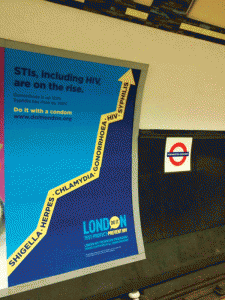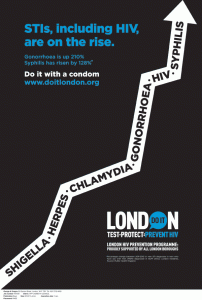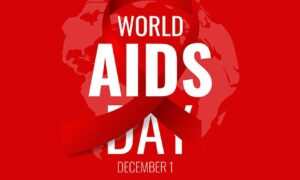Following his column in last week’s issue of Boyz, Paul Steinberg, Lead Commissioner of the London HIV Prevention Programme, gives a more in-depth explanation of Do It London’s new campaign, which aims to remind Londoners of the important role condoms still offer in protecting us against rising STIs.

The 2016 summer campaign focused on the importance of HIV testing – how do you know it was effective?
Working out how effective any campaign has been takes into account a number of different elements. At the time, we monitor uptake, reach and follow-up statistics (via doitlondon.org), which tells us how many people are engaging with the campaign via our social media, website and digital platforms. We saw a record number of visitors to the website during summer 2016, and our most popular page was how to find your local HIV testing service.
Following each campaign, we also carry out independent research with our key audience to test the messages, methods and strategy of Do It London. This helps us make improvements for the next campaign, and understand what works best for each target group. Last autumn, we asked 400 Londoners (including 100 gay men) what they thought about the campaign, including whether Do It London has affected their awareness and behaviour in relation to HIV testing.
What has feedback from the public been like regarding summer’s campaign?
We got some really positive ‘real time’ responses on social media, with people sharing the campaign, taking selfies in front of the adverts, and sharing its messages with their followers and friends. The formal research evaluation subsequently found that the campaign was very positively received. People said it was eye-catching and engaging, and they liked seeing HIV testing adverts that focused specifically on London all over the tube, buses and street billboards. Importantly, it also revealed that Do It London – with its combination tagline “Test, Protect: Prevent” – is promoting not just testing, but also discussions around safer sex with partners and friends. In statistical terms, the study showed two-thirds of respondents felt the campaign had positively influenced their practice of safer sex. Similarly, 68% reported that it had strongly influenced their behaviour towards HIV testing.
In terms of our overall strategic goal – to reduce new HIV infections and prevent late diagnosis – recent data from a number of London GUM clinics is very encouraging on that wider ambition. As I wrote in Boyz last week, it’s too early to establish if it represents a significant change to stubborn long term trends, but the news is exciting and a testament to everyone working, volunteering and campaigning to improve gay men’s sexual health.
Most importantly, of course, it’s down to the community, which is clearly responding to those multiple efforts. More men are now testing more often; they’re continuing to use condoms; they’re talking more openly about HIV with friends and partners; they’re advocating for and using PrEP; they’re accessing treatment and keeping themselves healthy. That’s a massive, collective achievement that should be celebrated very loudly.

Did you want to do anything different strategically for this new campaign?
Yes, this time we wanted to distil our message down to its simplest form, whilst broadening our focus to other sexually transmitted infections (STIs). We opted for a factual, no nonsense campaign which gives our audiences new information to motivate condom use. Behaviour change is not always successful when it tries to shock or scare; in fact that can have the opposite effect. So our message this time is honest and shares the latest information that ‘STIs are on the rise in London’ and to remind people that ‘doing it with a condom’ offers effective protection. It might seem old-fashioned, but in the context of broader sexual health in 2017, it’s really important to reinforce that message.
Why did you decide to target all STIs with today’s campaign?
The latest statistics from Public Health England showed such a sharp rise in almost all STIs that many public health experts across the city are concerned about possible ‘complacency’ around condoms and safer sex. It’s important that, as well as promoting regular testing, we also try to reduce new infections and talk more about preventing them in the first place. Highlighting this, in addition to other prevention methods, is difficult to pull off in one single advert. But we can’t avoid the statistics and must be aware of rising STIs, including those which are showing signs of resistance to frontline antibiotics. The tube advert says gonorrhoea and syphilis infection rates rose by 123 per cent and 108 per cent respectively between 2011 and 2015.
Does this mean more people are taking more risks or testing more regularly?
Those statistics are actually for the general population in London. For MSM (men who have sex with men), the statistics are even higher: over the same period there was a 210 per cent increase in gonorrhoea and a 128 per cent rise in syphilis. We think it’s due to a combination of factors, including increased screening and higher incidence of infection. To bring down those rates also requires combined action. First, if we have multiple partners in short spaces of time we need to be screening more frequently, ideally every three months. Second, we need to be open and alert to our safer sex practices and levels of condom use and consider condom use not just in the context of HIV but also STI prevention. They are still one of the cheapest and simplest forms of protection, which is why the London HIV Prevention Programme gives away over one million free condom/lube packs every year across the scene.
More broadly, there’s little doubt that modern technology like websites and apps have made it easier and quicker to hook up for sex than before. That’s why we’ve expanded the outreach element of the programme to use digital media to promote testing and condom use. Our evaluation suggests that reaching guys through those online channels is beginning to have a positive impact.
You’ve made HIV equal with STIs in the campaign – is this because STIs have gone off people’s radar with all the focus on HIV testing, PEP and PrEP etc?
Perhaps, but it’s also because the historic separation of HIV from other STIs has led, at times, to a silo approach. We want people to care broadly about their sexual health and to recognise where STI prevention fits into that, against a context of ever-busier sexual health clinics and reducing public health budgets. We’ve also seen some research to suggest that some gay and bi men are bored of the ‘get tested’ messages, which have been so prominent for the last decade, so we have to maintain our relevance to what motivates our audience to have a good, safe and healthy sex life.
We also want to keep the campaign as fresh and responsive as possible. In light of those striking STI statistics it became clear we should create a new campaign about condom use.
The 2016 summer campaign used eye-catching bright colours, while today’s campaign is simple in concept and stark in appearance – what was the thinking behind the new look?
We tailor each message to the channel we are using and also to the specific audience that we want to reach. This is a factual campaign with a stark message and simple piece of advice, so the design seems to fit the message quite well.
How does an increase in PrEP publicity and awareness impact on a sexual health campaign like Do It London?
Any story about HIV increases awareness on some level, so PrEP featuring in the news often last year will clearly have boosted publicity about HIV prevention beyond the reach of any grassroots campaign. That has definitely amplified our ‘Test and Protect’ message, as PrEP offers a very significant form of protection against HIV for our community, although it’s still not yet available on the NHS. In London, which accounts annually for around half of all new diagnoses, the combination of big adverts alongside news coverage of PrEP, provided a combination of interventions to raise awareness about the virus. Yet some experts think that the emphasis on HIV testing and PrEP might have led to a drop in condom use – hence this new campaign, which is our third in just one year.
What was it like for you personally creating this latest campaign? Has it been challenging?
Every phase of the campaign is challenging as we juggle value for money, relevance and impact with a very short turnaround between concept and publication. We also have to speak to lots of different audiences – the general London public, gay men, black Africans – using a very limited budget, and keep up to date with the latest media to make sure we’re reaching people in the right places. But I think Londoners should be proud that, despite the very tough time for public spending, all 33 London boroughs have prioritised HIV prevention through the London HIV Prevention Programme and the Do It London campaign. The fact we’re starting to see a drop in new HIV diagnoses makes all the hard work worth it – although there is still so much more to do to improve sexual health in the capital.
For more information and signposting to HIV and STI help, visit doitlondon.org.
You can follow the campaign on Twitter @DoItLDN and Facebook DoItLDN.














